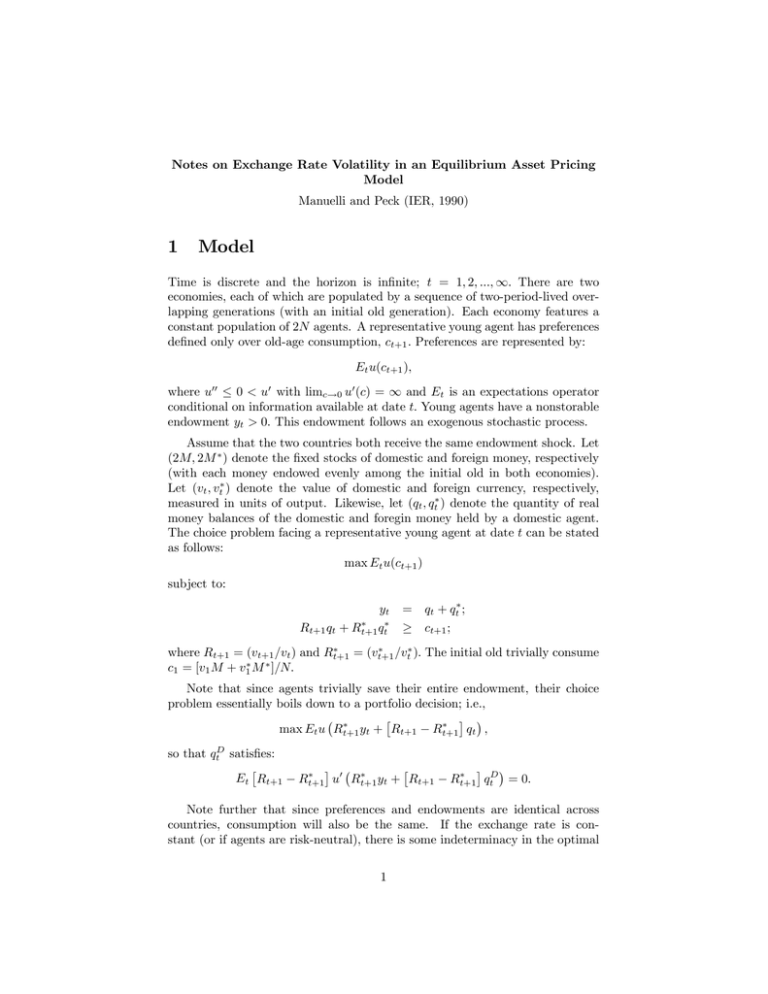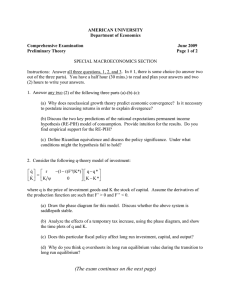1 Model
advertisement

Notes on Exchange Rate Volatility in an Equilibrium Asset Pricing
Model
Manuelli and Peck (IER, 1990)
1
Model
Time is discrete and the horizon is infinite; t = 1, 2, ..., ∞. There are two
economies, each of which are populated by a sequence of two-period-lived overlapping generations (with an initial old generation). Each economy features a
constant population of 2N agents. A representative young agent has preferences
defined only over old-age consumption, ct+1 . Preferences are represented by:
Et u(ct+1 ),
where u00 ≤ 0 < u0 with limc→0 u0 (c) = ∞ and Et is an expectations operator
conditional on information available at date t. Young agents have a nonstorable
endowment yt > 0. This endowment follows an exogenous stochastic process.
Assume that the two countries both receive the same endowment shock. Let
(2M, 2M ∗ ) denote the fixed stocks of domestic and foreign money, respectively
(with each money endowed evenly among the initial old in both economies).
Let (vt , vt∗ ) denote the value of domestic and foreign currency, respectively,
measured in units of output. Likewise, let (qt , qt∗ ) denote the quantity of real
money balances of the domestic and foregin money held by a domestic agent.
The choice problem facing a representative young agent at date t can be stated
as follows:
max Et u(ct+1 )
subject to:
Rt+1 qt +
yt
∗
Rt+1
qt∗
= qt + qt∗ ;
≥ ct+1 ;
∗
∗
where Rt+1 = (vt+1 /vt ) and Rt+1
= (vt+1
/vt∗ ). The initial old trivially consume
∗
∗
c1 = [v1 M + v1 M ]/N.
Note that since agents trivially save their entire endowment, their choice
problem essentially boils down to a portfolio decision; i.e.,
¤ ¢
¡ ∗
£
∗
max Et u Rt+1
qt ,
yt + Rt+1 − Rt+1
so that qtD satisfies:
£
£
¤ 0¡ ∗
¤ D¢
∗
∗
Et Rt+1 − Rt+1
u Rt+1 yt + Rt+1 − Rt+1
qt = 0.
Note further that since preferences and endowments are identical across
countries, consumption will also be the same. If the exchange rate is constant (or if agents are risk-neutral), there is some indeterminacy in the optimal
1
portfolio but all such portfolios buy the same (expected) consumption. If the
exchange rate fluctuates, then there is a unique optimal portfolio (if agents are
risk-averse) so, again, consumption is the same across countries. Since all equilibria involve no net trade of goods between countries, we can without loss focus
on symmetric equilibria where agents in each country hold the same portfolio
(so that we need not introduce notation to distinguish between domestic and
foreign agents). In this case, we have:
vt M
∗
vt M ∗
= N qtD ;
= N qt∗D .
For simplicity, let us normalize such that M = M ∗ = N = 1, so that qtD = vt
and qt∗D = vt∗ . Now, from the bugdet constraint:
ct+1
∗
= Rt+1 qtD + Rt+1
qt∗D ;
∗
= Rt+1 vt + Rt+1 vt∗ ;
∗
= vt+1 + vt+1
.
The relevant money market clearing condition is given by:
vt M + vt∗ M ∗ = N yt ∀ t;
Since this condition must hold at all dates, we have:
∗
vt+1 + vt+1
yt+1
=
.
∗
vt + vt
yt
The equation above represents the (gross) real rate of return on a diversified
(symmetric) portfolio (i.e., in equilibrium, each young agent purchases one unit
of domestic money and one unit of foreign money). Combining the money
market clearing condition with the budget constraint reveals that ct+1 = yt+1 ;
so we have the following restriction on equilibrium rates of return:
£
¤ 0
∗
Et Rt+1 − Rt+1
(1)
u (yt+1 ) = 0.
This equation may alternatively be written as:
£
¤
¤ 0
£
∗
∗
Et Rt+1 − Rt+1
Et u0 (yt+1 ) + cov t ( Rt+1 − Rt+1
, u (yt+1 )) = 0.
2
(2)
Constant Exchange Rate Equilibria
Assume that yt = y, so that there is no ‘fundamental’ uncertainty. This restriction does not rule out the possibility of randomness in ‘non-fundamentals.’ In
this section, however, assume that Rt and Rt∗ are deterministic. In this case,
condition (1) reduces to:
∗
Rt+1 = Rt+1
.
2
Let et denote the value of foreign money measured in units of domestic
money, so that vt∗ = et vt . Then this latter equation can be written as:
µ
¶
et+1
Rt+1 =
Rt+1 ;
et
which implies:
et+1 = et = e.
In other words, in the absence of any uncertainty, the equilibrium exchange rate
must be constant. From the money market clearing condition,
vt + vt∗
(1 + et )vt
= y;
= y;
so that the (common) equilibrium rate of return on money is given by:
∗
=
Rt+1 = Rt+1
(1 + et+1 )y
= 1.
(1 + et )y
Note that since both currencies earn the same rate of return R = R∗ = 1, the
optimal portfolio decision at the individual level is indeterminate. That is, both
currencies are literally perfect substitutes; since each is as good as the other,
individuals are willing to hold any combination of (q, q ∗ ) such that q + q ∗ = y
(note: here, y corresponds to the demand for total real balances). Since vt = qt ,
we can rewrite the money market clearing condition as:
(1 + e)q = y.
But since q is indeterminate, so is e. In other words, any e satisfying 0 < e < ∞
is consistent with an equilibrium in which both currencies are willingly held.
This is just the Kareken and Wallace (1981) indeterminacy result.
Imagine now that yt follows a stochastic process. The question I ask here is
whether et = e is still an equilibrium. To see whether this is the£ case, assume¤
∗
∗
that et = e. In this case, Rt+1 = Rt+1
; which obviously implies Et Rt+1 − Rt+1
=
0. In this scenario, the (common) equilibrium rate of return on money is given
by:
yt+1
∗
Rt+1 = Rt+1
=
.
yt
Of course, this rate of return is random, so that individuals attain an expected
utility Et u(yt+1 ). From the money market clearing condition, we have:
(1 + e)vt = yt .
Once again, the two currencies are viewed as perfect substitutes. Thus, for a
fixed e, individuals are perfectly willing to hold qt = vt and qt∗ = vt∗ units of
3
domestic and foreign money (respectively) in their portfolios, where
µ
¶
1
vt =
yt ;
1+e
µ
¶
e
vt∗ =
yt .
1+e
In this equilibrium, both the domestic and foreign price-levels fluctuate in
exactly the same way. The rate of return on money fluctuates, but since the
exchange rate is fixed, the returns on both monies fluctuate in exactly the same
way. Thus, in this model, changing fundamentals need not induce fluctuations
in the equilibrium exchange rate. As a corollary, it follows that bi-lateral fixed
exchange rate system—or a currency union—is consistent with efficiency.
3
Volatile Exchange Rate Equilibria with Constant Fundamentals
Let us return now to the case in which there is no ‘fundamental’ uncertainty, so
that yt = y. Now, since u0 (y) is a constant, we can write the restriction (1) as:
£
¤
∗
Et Rt+1 − Rt+1
= 0;
∙
¸
et+1 vt+1
vt+1
Et
−
= 0;
vt
et vt
which reduces to:
Et et+1 vt+1 = et Et vt+1 .
From the money market clearing condition, vt + vt∗ = y; or (1 + et )vt = y.
Recall, as well, that qt = vt and qt∗ = vt∗ . Now, let’s follow Manuelli and Peck
(1990), and define the variable αt by:
vt ≡ αt y.
Here, αt has the interpretation of being the fraction of one’s (real) saving allocated to the domestic currency. We want to restrict attention to situations
where both currencies are always valued; i.e.,
0 < αt < 1.
Now, use this definition and the money market clearing condition to write
et = (1 − αt )/αt . Substituting this into our earlier restriction:
Et
µ
Et et+1 vt+1 = et Et vt+1 ;
µ
¶
¶
1 − αt
1 − αt+1
αt+1 y =
Et αt+1 y;
αt+1
αt
αt Et (1 − αt+1 ) = (1 − αt )Et αt+1 ;
4
which reduces to:
αt = Et αt+1 .
(3)
Proposition: (Manuelli and Peck, 1990). Any stochastic process {αt }∞
t=1 satisfying 0 < αt < 1 and condition (3) constitutes an equilibrium (with
both monies valued); with vt = qt = αt y; vt∗ = qt∗ = (1 − αt )y and
et = (1 − αt )/αt .
Remark: Note that (3) implies that each country’s respective price-level follows a martingale (with the price-level in each country being perfectly
negatively correlated with each other); in particular, it does not imply
that the exchange rate itself is a martingale. In fact, the theory predicts
that (1 + et )−1 follows a martingale; i.e., one can rewrite (3) as:
(1 + et )−1 = Et (1 + et+1 )−1 .
3.1
Example
Let {αt }∞
t=1 follow the process:
αt+1 = αt + ηt+1,
£
¤
where ηt+1 ∼ U [−κt , κt ] and κt ≡ min{αt , 1 − αt }. Note that E η t+1 | αt = 0
so that E [αt+1 | αt ] = αt , as required (note: we are free to choose 0 < α1 < 1
arbitrarily).
5







